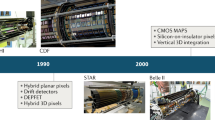Abstract
With increasing luminosity of accelerators for experiments in high energy physics the demands on the detectors increase as well. Especially tracking and vertexing detectors made of silicon sensors close to the interaction point need to be equipped with more radiation hard devices. This article introduces the different types of silicon sensors, describes measures to increase radiation hardness and provides an overview of the present upgrade choices for experiments in high energy physics.
Alexander Dierlamm for the CMS Collaboration.
Access this chapter
Tax calculation will be finalised at checkout
Purchases are for personal use only
Similar content being viewed by others
References
M. Moll, Ph.D. thesis, DESY-THESIS-1999-040 (1999)
T.R. Oldham, F.B. McLean, IEEE Trans. Nucl. Sci. 50, 483–499 (2003)
J. Zhang, Ph.D. thesis, DESY-THESIS-2013-018 (2013)
M. Printz, NIM A 831, 38–43 (2016) ; R. Dalal et al., JINST 9, P04007 (2014)
CMS Collaboration, CMS-DP-2015-022, http://cds.cern.ch/record/2039908
B. Hyams et al., NIM Phys. Res. 205, 99105 (1983)
G. Casse, NIM A 612, 464–469 (2010)
D. Contardo et al., CERN-LHCC-2015-010
ATLAS Collaboration, CERN-LHCC-2012-022
A.-M. Magnan, JINST 12, C01042 (2017)
LHCb Tracker Upgrade Technical Design Report, CERN-LHCC-2014-001
S.I. Parker et al., NIM A 395, 328–343 (1997)
https://www.fbk.eu; http://www.imb-cnm.csic.es; https://www.sintef.no/en/
The ATLAS IBL Collaboration, JINST 7, P11010 (2012)
M. Backhaus, NIM A 831, 65–70 (2016)
P. Yang et al., JINST 10, C03030 (2015)
G. Contin et al., JINST 10, C03026 (2015)
I. Perić et al., NIM A 731, 131–136 (2013)
The Mu3e Experiment, http://www.psi.ch/mu3e/
H. Augustin et al., JINST 11, C11029 (2016)
S. Terzo et al., JINST 9, C12029 (2014)
N. Savic et al., NIM A 845, 154–158 (2017)
Author information
Authors and Affiliations
Corresponding author
Editor information
Editors and Affiliations
Rights and permissions
Copyright information
© 2018 Springer International Publishing AG, part of Springer Nature
About this paper
Cite this paper
Dierlamm, A. (2018). Silicon Sensors for Experiments in High Energy Physics. In: Naimuddin, M. (eds) XXII DAE High Energy Physics Symposium . Springer Proceedings in Physics, vol 203. Springer, Cham. https://doi.org/10.1007/978-3-319-73171-1_2
Download citation
DOI: https://doi.org/10.1007/978-3-319-73171-1_2
Published:
Publisher Name: Springer, Cham
Print ISBN: 978-3-319-73170-4
Online ISBN: 978-3-319-73171-1
eBook Packages: Physics and AstronomyPhysics and Astronomy (R0)




